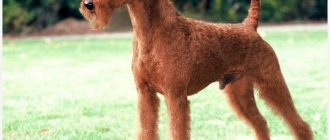The mysterious and multifaceted history of the Chihuahua, as a separate breed, began in the distant past. There are several versions of the origin of the decorative dog. But scientists agreed on one statement: this ancient American breed developed naturally. The Chihuahua can literally be called a purebred breed, since dogs of other breeds did not participate in its creation. What versions and legends exist about the history of the origin of the dog, you will learn from this article.
History of the name of the breed
Some experts associate the origin of the Chihuahua with the Aztec tribes. Small dogs were revered and sacred. It is believed that the dog, more similar to the modern Chihuahua, was the result of crossing Aztec Techichi and Chinese hairless dogs.
Another version says that the homeland of the Chihuahua is Malta. Small animals from the canine family inhabited the ancient territory. They were distinguished by their characteristic muzzle and fontanel on their head. In addition, images and sculptures of similar dogs are found in Egyptian graves that are more than three thousand years old.
However, all these are just assumptions about who Chihuahuas originated from. If we talk about more modern times, small dogs are found in history in the 18th and 19th centuries. They had many different names, including Texas, Mexican and so on.
For reference! The official name comes from the Mexican state of Chihuahua. A small flock of miniature dogs was found there. In the 19th century, these dogs began to be imported to the United States and the name of the breed was finally fixed.
Breed standard
Chihuahuas are pets with an unusual appearance. This is due to the fact that they come from the ancient Mexican Techichi dogs. But they were crossed with terriers, pinschers, and spitz dogs. The result is a mini pocket dog. The Chihuahua standard, with minor changes, was adopted in 2010.
According to him, this is a small dog, the height at the withers of which is from 15 to 23 cm, and females are slightly larger than males. Chihuahuas can weigh from 500 g to 3 kg, the most common parameters are 1.5-2.5 kg.
Head
This dog's head is large and round. The shape resembles an apple. The muzzle is cone-shaped, but wide and short. The transition from forehead to muzzle is clearly pronounced. The lips fit tightly to the jaw, the bite is scissor-shaped, but can be straight.
Chihuahuas' eyes are large, round, and sometimes protruding. They should be dark. The nose is short and slightly turned up. The color of the lobe is preferably black, but sometimes it is brown or light. Chihuahuas have large erect ears. They are triangular, wide at the base and set high. When the dog is calm, the ears are spread apart.
Torso
The build of these dogs is usually stocky and strong. Only minis can be graceful, with thin legs. But usually this dog has a compact body, a muscular build, a straight back, and does not sag towards the croup. The chest is wide, deep, the stomach is tucked. The neck is muscular and of medium length. The tail is short and set high. It is curved like a sickle towards the lower back.
Limbs
The front legs are straight, set parallel, elbows tightly pressed to the sides. The hind legs are also parallel and muscular. The feet are small, arched, and the toes are slightly spaced.
Wool
Chihuahuas come in short-haired and long-haired varieties. The first hair is smooth and fits tightly. The shortest fur is on the head, and the longer fur is on the ears and tail. The long-haired variety is soft, wavy, and has a thick undercoat. The longest hairs are on the ears, neck and paws.
The Chihuahua's coat color can be almost any color. Regardless of whether a dog is short-haired or long-haired, its colors are white, black, red, lilac, and blue. There are several common colors of Chihuahuas.
- White Chihuahuas come without any admixture of other shades.
- Completely black Chihuahuas are rare. They usually have white or milky tan marks on their toes, tail, and chest.
- Chocolate Chihuahuas are brown and have a reddish tint.
- Dogs can be red and tan. Color varies from light to chocolate.
- The brindle color looks unusual. It's fawn with a lot of black, it can be any pattern.
Defects in appearance
Representatives of this breed can differ greatly from each other in external qualities. There are certain standards that they must meet. For those who buy this little dog for themselves, this is not so important. But there are several defects due to which a dog will not be allowed for exhibitions and breeding:
- deep-set or bulging eyes;
- short neck;
- narrow elongated muzzle;
- short or pointed ears;
- open fontanel on the skull;
- long body;
- high legs and small head;
- deviations from norms of weight and height;
- marble color.
The photographs show how smooth-haired and long-haired purebred dogs should look correctly:
Smooth coated chihuahua
Longhaired Chihuahua
The main versions of the origin briefly
Chihuahua dogs - where did the breed come from? As already mentioned, there are quite a lot of options and some sometimes contradict each other. The most popular and well-known are discussed below.
European origin theory
According to this theory, miniature dogs appeared not in America, but in Europe. As already mentioned, according to this version, the ancestors of the Chihuahua appeared in Malta; at that time they were called pocket dogs. A distinctive feature of the breed was that there was a small depression on the skull (fontanel), which did not go away with age.
As confirmation of the theory, many cite as an example the Botticelli fresco entitled “Confessions of Moses.” If you look closely, one of the boys depicted is holding a small white dog, very similar to a Chihuahua.
Interesting! This theory has been disputed many times. It is believed that the fresco depicts Techichi, which was brought from America to Europe. However, the creation of the work took place during the period when Columbus had not yet discovered the mainland, and accordingly, such information simply did not exist.
Fresco by Botticelli
Breed traits
Breed traits (on a 5-point scale)
| Chihuahua | |||
| Activity | in the house | 3.3 | |
| on the street | 3.2 | ||
| Obedience | training | 3.3 | |
| strangers | 3.4 | ||
| Domination | in family | 2.5 | |
| over dogs | 3.2 | ||
| Defending your territory | from people | 3.1 | |
| from dogs | 3.5 | ||
| Sociability | in family | 4.5 | |
| with strangers | 3.2 | ||
| with dogs | 2.5 | ||
| Concentration | in family | 1.2 | |
| in front of strangers | 2.5 | ||
| with dogs | 3 | ||
| Aggressiveness | in family | 1.6 | |
| to strangers | 2.4 | ||
| to the dogs | 3 | ||
| to cats | 2.9 | ||
| Family behavior | calmness | 3.8 | |
| demand for affection | 4.5 | ||
| excitability | 4.1 | ||
| playfulness | 4.2 | ||
| excessive barking | 2.8 | ||
| behavioral breakdowns | 1.6 | ||
| Tolerance for children | up to 4 years | 2.9 | |
| over 4 years old | 3.4 | ||
| Institutional use | watchman | 3.8 | |
| bodyguard | 2.1 | ||
This breed is often compared to the following dog breeds: Pomeranian, Papillon, Miniature Pinscher, Yorkshire Terrier, Jack Russell Terrier.
Mexican origin theory
At the moment, among the theories about where the Chihuahua breed came from, the Mexican version is in the lead. It sounds the most plausible and is considered generally accepted.
The main confirmation is that modern canines and ancient Mexican dogs share common genes. This was confirmed by DNA research.
Wild Chihuahuas in Mexico were small in size, rather stocky and short-haired. They were called Techichi.
For reference! It is believed that they appeared in the 15th century BC and existed until the 16th century AD.
As already mentioned, these animals were considered sacred by the Aztecs. Their main function was to protect the owner from otherworldly forces. After the death of the owner, the animal was buried with him in order to take on all human sins.
Interesting facts about Chihuahuas
- For many years, the Chihuahua held the title of the smallest dog breed. This achievement was officially recorded in the Guinness Book of Records.
- The general public learned about the breed in the late 90s, when it appeared on the big screen. The Taco Bell restaurant chain has launched a series of television commercials. The main character was a talking chihuahua boy named (Gidget). Due to its great popularity, the little dog later became a recognizable mascot of the corporation. Several videos featuring Gidget were released: “Viva Gorditas!”, “Yo Quiero Taco Bell” and “Drop the Chalupa!” Carlos Alazraqui gave his voice to the Chihuahua.
- Police and Chihuahuas - what could they have in common? However, in 2010, the police department of the city of Nara, in Japan, recruited a 1.5-kilogram dog Momo. The dog successfully searched for injured people in the rubble caused by regular natural disasters.
- It is a fact that large dogs live significantly shorter lives than small ones. A tiny Chihuahua can live from 10 to 18 years. Centenarians have also been recorded, living for more than 20 years.
- Chihuahuas hardly get along with other breeds. Only with their own kind can they get along well. Despite their small size, miniature dogs are very aggressive.
- Dogs are in contact with all family members, but most of all they become attached to one single person. It is to him that complete loyalty will be shown.
- The International Canine Federation, as well as other competent organizations, recognize only two official classifications of the breed: longhaired and smoothhaired.
If you decide to get a dog, especially a puppy, then get ready for the following: you will often have to clean up little mistakes after the puppy; investments will be required in annual vaccinations, feeding, toys, ammunition, etc.; any animal requires attention and communication, so if you don’t have time, then there will be no mutual understanding with your Chihuahua puppy. Big changes are coming in your life. If you can handle this, you will find a loyal friend for life.
Other versions
There are many more theories about the Chihuahua and its country of origin. A few of the most interesting:
- In the Chinese version, it is believed that the ancestors of the modern Chihuahua were Techichi and Chinese hairless dogs. In this case, the formation of the rock occurred on board a Spanish ship, where representatives of the rocks were located.
- Another option is that the origin of the Chihuahua breed dates back to ancient Egypt. In this case, the ancestor was a small fennec fox. This theory is based on the fact that both representatives of the animal world have many similar features.
There are also some completely ridiculous variations of where Chihuahuas come from. One of these is related to aliens. It is believed that the non-overgrowing fontanelle is a kind of antenna that allows doggies to communicate with their people in a distant galaxy or with artificial intelligence.
Images of ancient dogs
Different versions
It is believed that the wolf is the progenitor of all dogs. The ancestor of the modern Chihuahua was a small species of Mexican wolf, Bailey. Mexicans call it "el lobo", which translated into Russian means wolf.
According to the first option, the Chihuahua breed originated three thousand years ago, during the construction of the Egyptian pyramids. Accordingly, supporters of this version believe that the country of Egypt is the birthplace of the decorative breed of dogs.
Some scientists are inclined to believe that the ancestor of the Chihuahua of our day can be identified as the big-eared fox - the fennec fox, which lives in the northern parts of Africa. She is similar to a Chihuahua not only in her small stature, but also in her huge eyes and ears.
There is also an opinion that the history of the origin of the decorative dog should be sought in the region of the island of Malta. It was there that there existed dogs with the same feature as modern representatives of the Chihuahua breed - a fontanel that almost never overgrows.
Numerous studies have proven that the toy dog of American origin has become the oldest dog breed that developed naturally, without infusions of dog blood from other breeds.
Baby girl's procession around the world
Ultimately, scientists were unable to find out for sure whose breed the Chihuahua actually is. But we know its development and how the dog got to different parts of the world.
Of course, the first country to officially recognize the new dog breed was America. In 1904, the small animal first appeared at an official exhibition.
The pet came to Europe in the 19th century. There is a rather interesting story about where such an unusual miniature animal could have come from in the Old World. It is believed that the pet could have originated in Europe because it was brought by the Mexican President as a gift to the opera diva Adeline Patti. The unusual situation was that the pet was sitting in a bouquet of flowers and patiently waiting in the wings.
The appearance of these animals in Canada was already associated with official recognition. The animals were brought there as a breed for further breeding. The same goes for England and Switzerland.
Origin and history of the formation of the Chihuahua breed
Home / ABOUT THE BREED / Origin and history of the formation of the Chihuahua breedThe origin of dogs of all breeds can usually be traced back to one common ancestor - the wolf. Even the smallest breeds are directly related in their origin to this large predator. Although true wolves, as we understand them, have never been found in South America, a small subspecies of wolf, distinguished by its dark color, still lives in Mexico and is called the Mexican wolf or Bailey's wolf. Most experts trace the Chihuahua breed's origins to "el lobo" (which means "wolf" in Spanish). For one reason or another—perhaps their diminutive size—the uninitiated often believe that the Chihuahua is much less of a real dog than other dog breeds. Thanks to the research carried out, it was nevertheless proven that the Chihuahua is the oldest breed of dog on the American continent and, in a sense, a real purebred breed (a breed that was bred from start to finish “in itself”, i.e. without infusion of blood from other breeds). Fans and experts of the Chihuahua breed claim that this breed occupies one of the most significant places in the history of ancient and modern dog breeding.
FROM THE DEPTH OF CENTURIES: A HISTORY FULL OF LEGENDS Chihuahua is the name of the border state of Mexico. And although this country has always been considered the birthplace of the breed, many of the most controversial hypotheses have now emerged about the origin of the Chihuahua outside of modern Mexico. Most of these hypotheses are somewhat speculative, but still quite interesting. The author of a very interesting, although dubious from a zoological point of view, theory claims that the ancestor of modern Chihuahuas was the fennec fox, or big-eared fox, living in the deserts of North Africa. Possessing huge ears (helping with cooling in hot climates) and large round eyes (adaptation to a nocturnal lifestyle), so reminiscent of the ears and eyes of a Chihuahua, the fennec fox is one of the few species of foxes that lead a gregarious lifestyle. This is the smallest representative of the canine family; the weight of the tiny fox is only 1.4 - 1.6 kg. According to other researchers of the origin and formation of the breed, the homeland of the Chihuahua should be sought in Europe, more precisely in Malta. On this island there already existed a small breed of dog, endowed, like the Chihuahua, with a distinctive natural feature - the “molera”, or parietal fontanel: a skin-covered space between the bones of the skull, present in newborn mammals, including humans, and named for the pulsation of blood visible to the eye under the skin. In other breeds of dogs, such a fontanel is extremely rare. The mummified remains of a small dog with a distinctive skull were also found in an Egyptian burial dating back to approximately 3 thousand years BC. A significant argument in favor of the hypothesis of the European origin of the breed is the wall painting “Scenes from the Life of Moses”, decorating the Sistine Chapel, created in 1482 by the famous Alessandro Botticelli, which depicts a dog remarkably similar to a Chihuahua. Note that this fact indicates the possibility of the existence of dogs of this breed in Europe long before the sailing of the caravels of Christopher Columbus. If such a hypothesis is correct, then it could happen that the Spanish conquistadors did not bring these dogs to the Old World, but, on the contrary, took them with them from Europe on a journey to the shores of India. One of the most popular newfangled versions of the origin of the Chihuahua is the Chinese one. Even in ancient times, the Chinese were famous for their success in breeding small breed dogs and could easily sell them to the Spaniards. If events really developed according to this scenario, the Spaniards took these dogs with them to Mexico. Having destroyed the Aztec civilization, the Spaniards moved further inland, leaving their dogs in the care of the surviving aborigines. HISTORY OF THE BREED IN MEXICO According to the most common and most plausible theory, Chihuahuas originate from Mexico. Archaeological finds confirm the fact that the history of breeding this breed began already in the 5th century AD, and suggest that these dogs were distributed not only in the central and southern regions of Mexico, but also in South America. The probable homeland of this breed is still considered Mexico. It is known that members of the Toltec tribe, whose culture originated in northern Mexico and then spread to its central and southern regions around 950 AD, kept small dogs that were very treasured. The breed was known as Techichi. Techichis were larger than modern Chihuahuas and had longer hair. Fun fact: they were mute. Images of these dogs, so similar to Chihuahuas, were found in drawings of the period, for example in paintings on stones from the Cholula pyramid, plundered in 1530. When the Toltec tribe was conquered by the Aztecs, Techichi continued to play the role of a symbol of happiness and prosperity among the new owners. Some families owned hundreds of dogs, which were cared for by special slaves. Archaeologists find Techichi remains at all ancient burial sites throughout Mexico. Probably, the ancient tribes had the following custom: when death approached, a man expressed a desire to be buried with his dog. Although this can be regarded as a manifestation of love, in fact, the emergence of such a custom was rather dictated by a sense of self-preservation. The dog was supposed to be sacrificed after the death of its owner as a ritual of transferring all the sins of the deceased onto the dog. Thus, the deceased was freed from responsibility for unrighteous deeds. This guaranteed the owner a peaceful existence in the kingdom of the dead. In some cases, instead of real dogs, sculptures of them were used in the ritual. Sacrifices were common in those days, and although it is difficult for us to understand, the Aztecs did not regard such an act as cruelty. On the contrary, they believed that they assigned a very honorable role to the victim. The favorite objects of sacrifice were dogs with red-red necks, and extremely rare dogs of a bluish color were declared sacred. Until now, the “blue” Chihuahua is perceived as the greatest value. One theory of the origin of the breed states that the modern Chihuahua is the result of crossing the Techichi and the Asian Hairless Dog, representatives of which lived on Spanish ships as rat hunters. Many modern breeders find this ridiculous, however, we must pay tribute to the courage of this assumption. Perhaps no other breed can boast of a history so rich in legends, speculation and hypotheses. However, all these speculations are unprovable, and the past of the Chihuahua continues to remain mysterious. In Mexico, the Chihuahua breed is known as “el chihuahueco” - “el chihuahueno”, that is, “Chihuahuan”, “resident of Chihuahua”. HISTORY OF THE BREED IN THE USA American archaeologists first discovered the remains of Chihuahuas in 1850 in the Mexican border state for which the breed is named, but the first Chihuahuas imported into the States were called “Texas” or “Arizona dogs.” Since then, at the end of the 19th century, Mexicans began selling these dogs to American tourists in the border areas. Famous American dog trainer James Watson purchased his first Chihuahua for just a few dollars in El Paso, Texas, in 1888. Watson subsequently acquired several more representatives of this unique breed. It is believed that these first dogs were crossed with the black and tan English Toy Terrier to give rise to the modern smooth-coated Chihuahua. Long-haired Chihuahuas are the result of crossbreeding between dogs imported from Mexico and various small breeds such as the Spanish Papillon or Pomeranian Dwarf Spitz. When dog fighting was banned in the 1930s and 1940s, various dog shows and competitions began to develop, the purpose of which was to provide owners with the opportunity to show their pets in the most favorable light. The first exhibition of this kind was held in England in 1859, and the first exhibition on the North American continent was organized in Quebec in 1867. There were no breed standards back then, and judging was problematic. The rules could be different for each show. There were also no rules of behavior in the ring; dogs often hurt each other. The Kennel Club (KC) of Great Britain (Kennel Club, or KS - KC) was founded in 1873, its tasks included the development of official breed standards. The American Kennel Club (AKC, or in English AKC - American Kennel Club) was founded in 1884 and developed the basic rules for behavior in the show ring. In 1888, the formation of the Canadian Kennel Club (or SKS - C.K.C.) followed. Today, these clubs are non-profit public organizations whose members work together to create and improve dog breed standards, register and hold exhibitions. There are now many such clubs around the world, but KK and ACC are the most prominent. The first Chihuahua named Midget was registered with the ACC in 1904. A few years later, several more Chihuahuas were registered with the club, and in 1915 the number reached 30. Today, more than 40,000 dogs are registered with the ACC each year. Until 1952, long-haired and short-haired Chihuahuas were shown together, then the ACC decided to distinguish two types within the breed. Today, these types are often crossed, and the same litter can contain both long-haired and smooth-haired puppies.
Source: Jan T. Chihuahua / T. Jan. - M.: Aquarium-Print LLC, 2007. - 192 p.
History of the appearance of the breed in Russia
Different types of hair on dogs
Dogs appeared on the territory of Russia quite late. According to official sources, representatives (boy and girl) of the breed were presented to Khrushchev when he visited Cuba. What is noteworthy, judging by the description provided, these were long-haired dogs.
It was the two above-mentioned animals that caused the breed to gain popularity among the Russian population. In addition, one of the pets became a movie star, starring in the famous Soviet film “The Elusive Avengers.” The dog was sitting in Buba’s arms.
However, for a long time such animals in Russia were only isolated representatives. They began to appear more massively in the mid-90s. The main problem was that the imported representatives of different species, when crossed with Russian ones, began to produce not the highest quality offspring.
Important! A little later, Russian cynologists began independently breeding the Russian variation of the breed.











